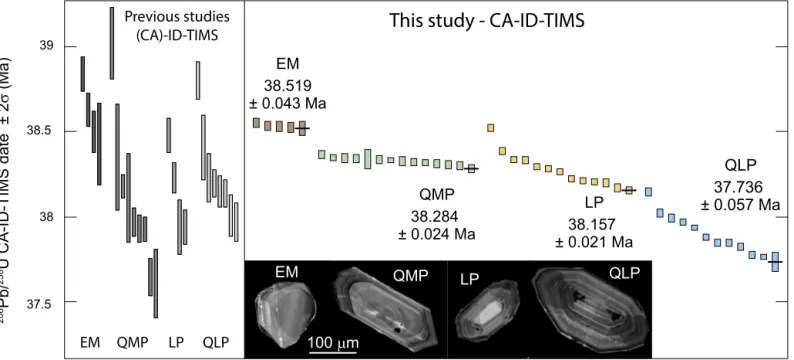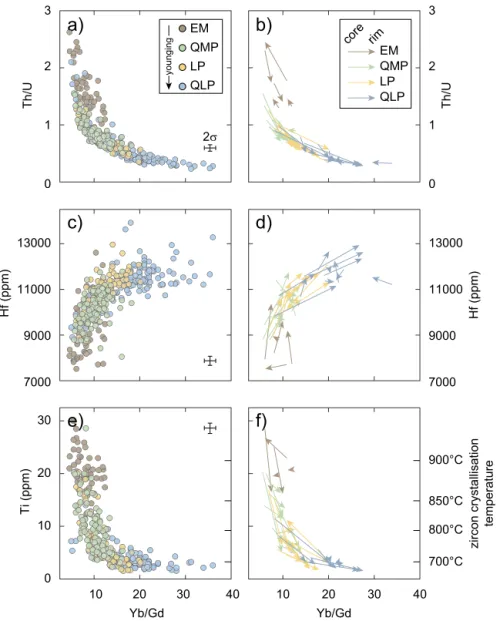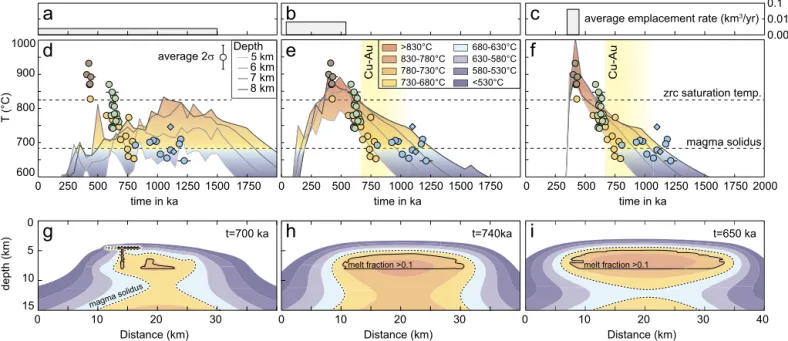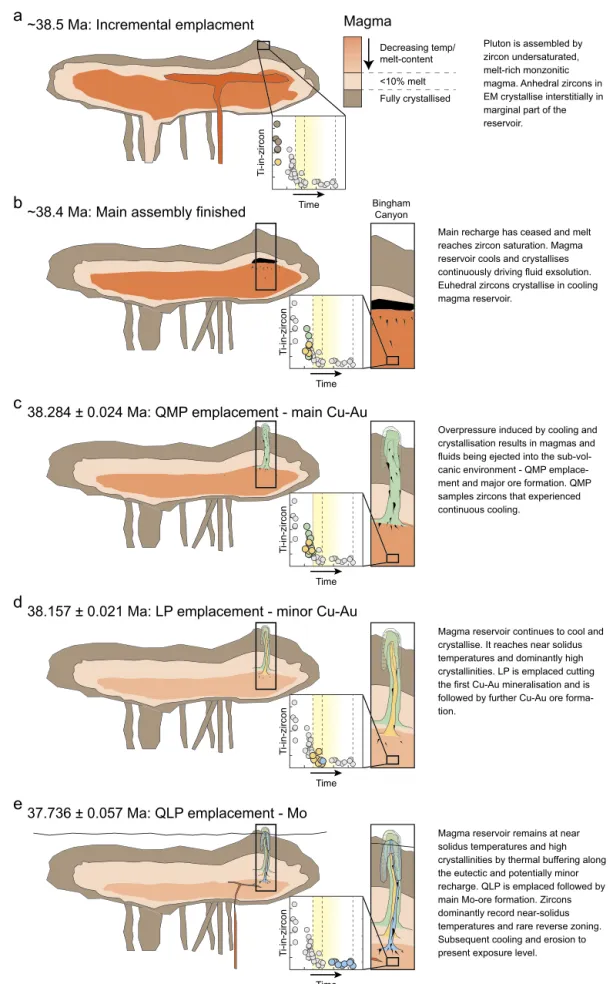Research Collection
Journal Article
Copper-mineralised porphyries sample the evolution of a large-volume silicic magma reservoir from rapid assembly to solidification
Author(s):
Large, Simon J. E.; Buret, Yannick; Wotzlaw, Jörn-Frederik; Karakas, Özge; Guillong, Marcel; von Quadt, Albrecht; Heinrich, Christoph A.
Publication Date:
2021-06-01 Permanent Link:
https://doi.org/10.3929/ethz-b-000477999
Originally published in:
Earth and Planetary Science Letters 563, http://doi.org/10.1016/j.epsl.2021.116877
Rights / License:
Creative Commons Attribution 4.0 International
This page was generated automatically upon download from the ETH Zurich Research Collection. For more information please consult the Terms of use.
ETH Library
Contents lists available atScienceDirect
Earth and Planetary Science Letters
www.elsevier.com/locate/epsl
Copper-mineralised porphyries sample the evolution of a large-volume silicic magma reservoir from rapid assembly to solidification
S.J.E. Large
a,∗,1, Y. Buret
a,1, J.F. Wotzlaw
a, O. Karakas
a, M. Guillong
a, A. von Quadt
a, C.A. Heinrich
a,baDepartmentofEarthSciences,EidgenössischeTechnischeHochschule(ETH)Zurich,8092Zürich,Switzerland bFacultyofMathematicsandNaturalSciences,UniversityofZurich,8006Zürich,Switzerland
a rt i c l e i n f o a b s t r a c t
Articlehistory:
Received16June2020
Receivedinrevisedform3March2021 Accepted5March2021
Availableonline30March2021 Editor:R.Dasgupta
Keywords:
zircon timescale magmareservoir copperporphyry petrochronology thermalmodelling
Volatile-rich intermediate to silicic magmatic systems can feed devastating volcanic eruptions but also generate valuable magmatic-hydrothermal ore deposits that supply most of the world’s copper.
Understandingthegeometry,dynamicsandtimescalesofthesemagmaticsystemsiscriticalindeveloping modelsforpredictingthe occurrenceoforedeposits andfuturelarge volcaniceruptions.Here,weuse zirconpetrochronologyfromanequigranularmonzonite and successivelyemplacedporphyrydykesto reconstructthetime–temperature–compositionevolutionofthemagmathatsourcedthegiantCu-Mo- AudepositatBinghamCanyon(USA).Combininghigh-precisionCA-ID-TIMSgeochronologywithin-situ trace element analyses by LA-ICP-MS shows the intra-grain, inter-sample and temporal geochemical changesrecording the evolution ofthe magmatic system over817± 62 kyr.Systematic variation of zirconchemistrywith time indicates crystallisationfroma coherentmagma reservoir. Afterreservoir assemblyitsthermal andchemical statewascontrolledby protractedmonotonous crystallisationover
∼650 kyr with rapid cooling over the first 200 kyr followed by a longer period approaching the granitesolidus.PorphyryCu-Auoreformationoccurredaftertheearlydropinmagmatemperaturethat resultedinlarge-scalefluidsaturationandexpulsionintothesub-volcanicenvironmentbutmain Mo- mineralisationoccurredafterprotractedlow-temperature magmastorageand theemplacementofthe lastporphyry.Zirconsdonotquantifythedepthofthisreservoirbutintegratingindependentgeophysical evidencewith2-Dthermalmodellingindicatesthatthetime–temperatureevolutionrecordedbythe zircons isconsistentwith rapidincremental assemblyofthislarge pluton(magma emplacementrate 0.0065 km3/yr) by initially zircon-undersaturated monzonitic magma intopre-heated upper crust.
Ourresultsindicatethatmassivefluidexpulsionfromrapidly-formed,largemagmareservoirscontaining mobilebutmushymagma(>40wt.%melt)canoccurintheuppercrust,favouringtheformationofgiant porphyrycopperdeposits.
©2021TheAuthor(s).PublishedbyElsevierB.V.ThisisanopenaccessarticleundertheCCBYlicense (http://creativecommons.org/licenses/by/4.0/).
1. Introduction
Porphyry Cu (-Au-Mo) deposits currently provide ∼75%, 20%
and50%oftheglobaldemandforCu,AuandMo,respectively(Sil- litoe,2010)andareanessentialsourceofmetalstoaccommodate society’s future demand. These magmatic-hydrothermal deposits formbetweentheplutonicandvolcanicdomainsofupper-crustal magmaticsystems,wherefocussed fluidextractionfrommagmatic systems results in the chemical concentration of economic met-
*
Correspondingauthor.E-mailaddress:s.large@nhm.ac.uk(S.J.E. Large).
1 Current address: Department of Earth Sciences, Natural History Museum, CromwellRoad,London,SW75BD,UK.
als around sub-volcanic porphyritic intrusions (Burnham, 1979;
Sillitoe, 2010). The chemical evolution of ore fluids and fluid- saturatingplutons havebeen investigated in detail (e.g.Roedder, 1971; Landtwingetal.,2005) andthisstudynowfocussesonthe thermal,geochemicalandtemporalevolutionofthemagmaticsys- tems sourcing the magmas, fluids and metals to generate these deposits.
Views regarding the makeup and dynamics of crustal-scale magmatic systems sourcing porphyry Cu-Mo-Au deposits, large eruptions and upper crustal plutons diverge significantly, even thoughthey haveincommonthe productionoflargevolumesof volatiles. Traditionally, porphyry deposits were considered to be theresultoffocussedfluid extractionfromlarge melt-dominated andconvectingmagmareservoirs(‘magmachambers’)crystallising intheuppercrust (Dilles,1987;Cloos,2001;Korgesetal.,2020).
https://doi.org/10.1016/j.epsl.2021.116877
0012-821X/©2021TheAuthor(s).PublishedbyElsevierB.V.ThisisanopenaccessarticleundertheCCBYlicense(http://creativecommons.org/licenses/by/4.0/).
Fig. 1.GeologicalsettingoftheBinghamCanyonporphyryCu-Mo-Audeposit:a) OverviewmapmodifiedfromJohn(1989):b) MapoftheOquirrhMountainshighlighting outcropsofEocenevolcanicandmonzoniticintrusiverocksandalargegeophysicalanomaly.Isoanomalylineshighlightthedeviationoftotalmagneticintensityfromthe GeomagneticReferenceFieldinnT,reducedtopoleandupwardcontinuedto3,300m(modifiedfromSteinbergeretal.,2013)andsuggestalargeconnectedmagmatic bodyatdepth.c)Geologicalmapoftheminearea,modifiedfromRedmondandEinaudi(2010).Locations:BC–BinghamCanyon,LC–LastChancestock,OM–Oquirrh Mountains,SC–SettlementCanyon,St–Stockton,SLC–SaltLakeCity;Lithologies:EM–equigranularmonzonite,QMP–quartzmonzoniteporphyry,LP–latiteporphyry, QLP–quartzlatiteporphyry.(Forinterpretationofthecoloursinthefigure(s),thereaderisreferredtothewebversionofthisarticle.)
Miaroliticcavitiesinlargegranitoidintrusionsprovidechemicalin- formationaboutlocallysaturatingfluidsthatresemble thosegen- erating porphyry deposits (Audétat, 2019). Similar quantities of hydrous magma (hundreds to thousands of km3) as needed to makegiantporphyrycopperdeposits(Dilles,1987;ClineandBod- nar, 1991; Steinberger et al., 2013) evidently exist in the upper crustassociatedwithlargecaldera-formingeruptions(Vazquezand Reid,2002;Huangetal.,2015;Riouxetal.,2016).However,inre- sponse tonewgeophysicalandanalytical dataaboutthe physical state and the characteristic time scales of eruptive volcanic sys- tems and deeply eroded plutons (Annen, 2009; Claiborne et al., 2010; Samperton et al., 2015; Delph et al., 2017; Karakas et al., 2017; Szymanowski etal., 2017) the classic view of large upper crustal magma chambers, filled by dyke orsill injection(Jellinek andDePaolo,2003; Schöpa etal., 2017) fromthedynamic lower crust (HildrethandMoorbath, 1988;Annenetal.,2006)hasbeen challenged(Cashmanetal.,2017;Jacksonetal.,2018).
Successivelyemplacedporphyrydykestypicallyassociatedwith porphyry copper deposits provide snapshots ofmagma extracted from the underlying magmatic system, commonly several times duringtheexpulsionoftheorefluids,providingdistinctgeological timelines during hydrothermal ore formation (e.g. Redmond and Einaudi,2010).Investigationofthesesmallintrusionsbybulk-rock or mineral chemical analyses is limited by pervasive hydrother- mal alteration that modifiesmostof their primary igneous min- eral cargo but the accessory mineral zircon is highly refractory andremains largelyunaffected(e.g.Cherniaketal.,1997).Zircons dominantlycrystalliseinthemagmaticsystemunderlyingthepor- phyry intrusionsbeforeporphyrymagma emplacementandrapid cooling (von Quadt et al., 2011; Tapster et al., 2016). Precisely datable zircons separated fromsuch temporally spaced porphyry samples providesnapshotsof progressivechanges inthe thermal andchemical stateoftheunderlyingcrystallisingmagmaoverex- tendedpartsofthelife-timeofanevolvingmagmaticsystem(e.g.
Buret et al., 2017; Large et al., 2020). Thus, the temporally re- solved zircon record has the potential to identifythe lifetime of crystallisingmagmasandtheirtime-temperature-chemistryevolu- tion,whichinturncanprovideinsightsintothedevelopmentand natureofthezirconcrystallisingmagmaticsystem.
Here, we present newhigh-precision zircon U-Pb geochronol- ogy andin-situ geochemistry including Ti-in-zircon temperatures totracktheformationandevolutionofthemagmaticsystemthat providedthesourceofthermalenergy,metalsandvolatilestothe giant Cu-Au-Modepositat BinghamCanyon, USA.A coherentin-
terpretationofthemagmaticsystemssourcingthisdepositresults fromthecombinationofthezircondatawithindependentpetro- logicalandgeophysicaldata,whichconstrainthermalmodellingof thismagmaticsystem.
2. GeologyoftheBinghamCanyonporphyrydeposit
Bingham Canyon (USA; Fig. 1), is one of the world’s largest (>26 MtCu, ∼1500 t Au, ∼1.5 Mt Mo(Porter etal., 2012) and beststudiedporphyrydeposits.ItispartoftheEoceneWasatchig- neousbeltstrikingeast-westandextendingovermorethan80km fromthe BasinandRangeprovince,acrosstheWasatchfaultinto the Rocky Mountains block. Economic mineralisation is centred around a composite intrusive stock emplaced into Carboniferous quartzites, limestones and siltstones of the Oquirrh Group (Red- mondandEinaudi,2010).
The calc-alkaline magmatism that produced Bingham Canyon was probablynot relatedtoconcurrent subduction, buthasbeen attributedtomildly extensional meltingintheEocene ofa man- tlelithospherethat hadbeenmetasomatisedbyPalaeoproterozoic subduction (Pettke et al., 2010; Porteret al., 2012; Griffin et al., 2013). Regardless of the tectonicsetting, the crustalevolution of Bingham Canyon and its association with hydrous, high-K, calc- alkaline,intermediatemagmas(Keithetal.,1997;Maughanetal., 2002) is similar to that of major porphyry deposits worldwide, making it a type example with regard to magma emplacement andmineralisingfluid evolution(Roedder,1971;Landtwingetal., 2005; Redmond and Einaudi, 2010; Sillitoe, 2010; Porter et al., 2012;Seoetal.,2012).
The mineralised Bingham stock is part of an Eocene mag- matic belt including local volcanic sequences, which are poorly constrained in age but largely erupted prior to or several mil- lionyearsaftertheemplacementofsubvolcanic intrusions(Deino andKeith, 1997; Biek, 2006). The Bingham stock as well as the nearbyLastChance,SettlementandStocktonstocksaredominated byequigranularmonzonite,adistinctlithologyemplacedfirstand makingupthebulkofallintrusiveexposures(Fig.1b).AtBingham a3 km× 3kmequigranular monzonite (EM)stock issucceeded byatleastfourphasesofporphyrydykeemplacement.Fieldrela- tionshipsshowthattheEMwascross-cutbythequartzmonzonite porphyry(QMP),followedsuccessivelybythecompositionallysim- ilarlatite porphyry (LP),the biotiteporphyry(BP) andfinallythe quartzlatiteporphyry(QLP;RedmondandEinaudi,2010).Contacts betweenthe intrusive rocks andwall rockbut also betweenthe
intrusivedykesthemselvesaredominantlysharphighlightingem- placement of the individual intrusionsinto colder wall-rock.The largest porphyry dyke in outcrop size is the 1500 m × 500 m QMP and the LP and QLP are successively smaller with the BP being the smallest intrusive unit (500 m × 4 m; Redmond and Einaudi,2010)besidesthinbiotite-richlamprophyricdykes(Deino andKeith,1997;Maughanetal.,2002).
The equigranular monzonite (EM) contains less than 2% pla- gioclase phenocrysts within a matrix ofinterlocked 0.5 mm pla- gioclase and clinopyroxene with interstitial K-feldspar, late mi- norhornblendeandquartzandaccessoryzircon,indicatingin-situ crystallisation frominitiallymelt-richmagma (RedmondandEin- audi,2010).Bycontrast,QMPandLPcontain50-60%phenocrysts ofplagioclase, amphibole, biotiteandK-feldsparup to 20mm in diameter in a micro-aplitic (0.2 mm) groundmass. A hybrid ver- sionofQMPshowstransitionalcontactstoEM(Porteretal.,2012).
Somewhat lower phenocrystcontents of25-40% butsimilar rela- tive proportions anda darker groundmass containing biotiteand amphibole characterise the later quartz-phyric QLP, whereas the BP contains ahigherproportionof biotitecomparedto theother intrusive dykes (Redmond and Einaudi, 2010). Each porphyry is associatedwithdiscreteveiningandalterationevents.Mostinten- siveveiningoccurredbetweentheQMPandtheLPwhich,together withdetailedmetal assaysonalocalscaleledRedmondandEin- audi(2010) tothesuggestthatupto90%CuandAuwasdeposited betweentheemplacementoftheQMP andtheLP. However,there is no systematic change in ore grade between the QMP and LP on themine-scale,suggestingthat mostofthe Cu wasdeposited withtheemplacementoftheQMPandshortlyafterLPbutclearly beforetheintrusion oftheQLP(Porter etal., 2012). Mostquartz- molybdeniteveinspostdateallintrusionsandaccountfor60–90%
of the Mo-ore (Lanier etal., 1978; Redmond andEinaudi, 2010;
Porteretal.,2012).
3. Materialsandmethod
3.1. Zirconpetrochronologyworkflow
Zircons and titanites were extractedfrom samples ofthe EM, QMP,LPandQLPusingconventionalmineralseparationtechniques includingSelFragdisintegration,sieving,panningandheavyliquid mineralseparation(methyleneiodide;3.3g/cm3).Hand-pickedzir- conswere annealedfor48 hat900◦C.Zirconsandtitaniteswere mountedinepoxy-resinandgrainmountswerepolishedtoreveal thecrystalinterior.Secondaryelectronmicroscope(SEM)cathodo- luminescence (CL) images were obtained using a Tescan EOscan VEGA XLSeries 4 Scanning Electron Microscope. LA-ICP-MS geo- chemistry andgeochronology analyses of coresandrims ofindi- vidual crystalswere conductedfollowingtheprocedures outlined by Largeet al. (2018: see supplementary materials for more in- formation). For trace element analyses NIST 610 glass was used asreferencematerial,withstochiometricconcentrationsofSi(zir- con) and Ca (titanite) asinternal standards. The accuracy of the measurements was monitoredby repeated analyses ofsecondary zircon standards (GJ-1, 91500 and synthetic zircon). Most trace elementshaveuncertaintiesbetterthan±5%(2RSD)basedonsec- ondarystandardandglassstandardreproducibility.Concentrations of Al, P, Ca, Mn orFe were monitored to avoid mineral ormelt inclusioncontamination. ConcentrationsforTiinzirconwerecor- rectedagainstzirconreferencematerial91500(Szymanowskietal., 2018).
Forty-three zircons from the four investigated samples show- ing no evidence of inheritance or contamination by inclusions were selected for chemical abrasion - isotope dilution - thermal ionisation mass spectrometry(CA-ID-TIMS)analyses. The selected crystalswereremovedfromtheepoxymount,chemicallyabraded
(CA)for 12-15 hat 180◦C usingtechniques modified fromMat- tinson (2005). Zircons were spiked with 6-8 μg of the EARTH- TIME 202Pb-205Pb-233U-235U tracer solution (ET2535; Condon et al.,2015;McLeanetal.,2015) anddissolvedinhigh-pressureParr bombsat 210◦C for>60 h.Dissolvedsamples were dried down and redissolved in 6N HCl at 180◦C for 12 h. U and Pb were separated using a single column HCl-based ion exchange chro- matography and loaded on outgassed Re filaments with a silica gelemitter. Allmeasurements were performedatthe Instituteof Petrology and Geochemistry at ETH Zurich employing a Thermo Scientific TRITON Plus thermalionisation mass spectrometer (for detailsconsultLargeetal.(2018) andthesupplementarymaterial).
Pbwas measuredsequentially ona dynamicMassCom secondary electronmultiplierandUwasmeasuredinstaticmodeasU-oxide usingFaradaycupsfittedwith1013resistoramplifiers(Wotzlaw etal., 2017).If intensities ofUduring static measurements were sufficientanonlineUO2interferencecorrectionwasapplied(Wot- zlawetal.,2017).
3.2.Mineralthermometry
Mineralthermometryofzirconandtitanitecanconstraincrys- tallisationtemperatures of individual mineraldomains. The ther- mometersaredependentontheactivitiesofSiO2 (aSiO2)andTiO2 (aTiO2)inthecrystallisingmeltandalsoweaklyonpressure(Ferry andWatson,2007;Haydenetal., 2007). Basedontheoccurrence ofquartzintheQMP,LPandQLPanaSiO2 of1wasassumedand thepressurewasfixedat2kbar.Higherassumedpressureswould increase calculated titanitecrystallisation temperatures, e.g. for6 kbartemperatureswouldincreaseby∼50◦C.TheaTiO2isdifficult toquantify,especiallyinalteredrocksrelatedtoporphyrydeposits.
We therefore use an approach where we matchthe Ti-in-zircon andZr-in-titanite thermometers(SupplementaryFig. 4). Basedon theco-occurrence oftitanite andzircon intheQLP andevidence for co-crystallisation by the geochemical evolution of zircon we assume that the majority of the titanite and zircon populations from the QLP have co-crystallised at the same temperature. Ap- plyingvaluesforaSiO2andpressureasoutlinedaboveandvarying theaTiO2 weidentifyan aTiO2 valueof0.5asthebestfitforour data-set.
No magmatic titanitecould be recovered fromthe other por- phyrysamples, QMP, LPandQLP, butpetrographic evidencesug- gestsreplacementofprimary titanite byhydrothermalrutile (see Supplementary Fig. 3)andthusthe sameaTiO2 was alsoapplied tozirconfromtheotherporphyrysamples.Toensurecomparabil- itybetweenzirconfromdifferentsamples wefurther propagated an uncertainty of ±0.1 in the activity of aTiO2 for the calcula- tion of the zircon crystallisation temperature to account for po- tentialvariation(typically<0.2forigneoussystems;Ghiorso and Gualda, 2012; Schillerand Finger, 2019), whichis a conservative estimationbased on the petrographic and geochemicalsimilarity between the different porphyry intrusions. The same aTiO2 was alsousedfortheEM,whichindeedcontainsabundantsmalltitan- itegrainswhich,however,aretexturally lateandmightbe either formedfromresidual melt orby incipientpropylitic alterationof Ti-bearingclinopyroxene.Thus, the determinedzircon crystallisa- tiontemperatures oftheEM are associatedwitha higherdegree ofuncertainty.Highestzirconcrystallisationtemperaturesfromthe QMP(∼850◦C)overlapwithzirconsaturationtemperaturescalcu- latedfromthe melt inclusion composition ofrelatively unaltered latiticdykesintheBinghamdistrict(∼830◦C:ZhangandAudétat, 2017) orthebulk rockcomposition ofa“hybrid QMP”(∼820◦C:
Maughanetal., 2002) thatprovidereasonableapproximationsfor theporphyrymagmas.
Fig. 2.RankedageplotofindividualCA-ID-TIMS206Pb/238Uzircondates with2σ uncertaintyofthefourmainintrusions;youngestzircondates determinemaximum emplacementagesthatagreewithfieldrelationships.PreviouslypublishedID-TIMSzircondates(Parryetal.,2001;vonQuadtetal.,2011)plottedforcomparisondonot resolvedefinedtemporaldifferencesbetweentheporphyryintrusions,reflectingadvancesintheanalyticaltechnique.Insetshowsrepresentativecathodoluminescenceimages ofzircons.EM=equigranularmonzonite,QMP=quartzmonzoniteporphyry,LP=latiteporphyry,QLP=quartzlatiteporphyry.
4. Results
In line with the textural contrast between the equigranular monzonite and the subsequent porphyries, the containedzircons also contrastpetrographically. Zirconsfrom the EMare distinctly anhedralwithdiffusebutsharplytruncatedgrowthzones,showing interstitial zircon crystallisation after pyroxene, whereas zircons from all porphyry intrusionsoccur aseuhedral phenocrystswith oscillatory zoning and occur anywhere within the groundmass or asinclusionsin phenocrysts ortheir alteration pseudomorphs (Fig.2,andSupplementaryFigs. 2, 3forpetrographicdetails).
4.1. CA-ID-TIMSgeochronology
Zircon206Pb/238UCA-ID-TIMSdatesfromBinghamCanyonspan atotalof817±62kyr(38.553±0.025to37.736±0.057Ma;Fig.2).
Eachoftheintrusionsexhibitarangeofzirconcrystallisationages, which is short in the oldest intrusion (EM:34±50 kyr)and ex- tendstoprogressivelylongertime-spansintheyoungerintrusions (QLP:410±61kyr),wherebytheolderzircondatesintheyounger porphyriesoverlapwiththoseofearlierintrusions.Therapidcool- ing and crystallisation rate of volumetrically small porphyry in- trusions in the sub-volcanic environment (≤10 kyr; e.g. Cathles, 1977) excludeszircon crystallisation attheemplacement level of theporphyryintrusionsgiventherecordedtimescales(>80kyrin QMPto>400kyrinQLP).Inlinewiththeeuhedralzirconshapes, thelargerangesinzirconcrystallisationageswithineachporphyry showthat thezirconscrystallisedintheunderlyingmagmaticsys- tem,ratherthanlocallyintheporphyriesattheirpresentlocation.
Zircongrowthinthesourcemagmaterminatedatthepointofex- traction of the volumetrically small porphyry intrusions into the sub-volcanic environment. Thus, we use the youngest individual zirconsofeachporphyry(QMP:38.284±0.024Ma;LP:38.157± 0.021Ma;QLP:37.736±0.057Ma)asthebestapproximationsfor the timeofporphyry emplacement.Theseobtainedemplacement ages are in agreement withcross-cutting relationships (Lanieret al., 1978; Redmond and Einaudi, 2010; Porter et al., 2012) and
overlapwithpreviouslower-resolution studies(Parryetal.,2001;
vonQuadtetal.,2011).
Basedondetailedmappingthemostprominentquartzveining eventcanbebracketedbytheemplacementagesoftheQMP and LP(127±32kyr; RedmondandEinaudi, 2010). Thistimewindow represents theminimumtimebracketonthedurationofCu-Auore formation.Ore-grade distributionmaps suggest that a portionof theCu-AumineralisationoccurredaftertheemplacementoftheLP (Porteretal., 2012). Thisindicates thatCu-Aumineralisationcon- tinuedbeyondemplacement oftheLP, butterminated beforethe emplacement ofthe QLP,which occurred548±61kyr after QMP anddefines the maximumbracket on the duration ofCu-Au ore formation.MostMo-oreformationoccurredafterthemainperiod ofCu-Auoremineralisation,aftertheemplacementoftheQLP.
4.2.Zircontraceelementevolutiononasample,grainandabsolute temporalscale
Theinvestigatedzirconsdisplaystronggeochemicalcorrelations ofdecreasing Th/UandTi with increasing HfandYb/Gd (Fig. 3).
These systematic variations are recorded within each porphyry sample, progressingfromthe oldertowards the youngersamples and are also recorded (Fig. 3a, c, e) by the intra-grain core-to- rimsystematicsofindividualzirconsfromtheporphyryintrusions (Fig.3b,d,f).ThechemicalsignatureoftheEMextendsthetrend oftheporphyryzirconsbacktoevenhigherTh/U,Yb/Gd,HfandTi, buttheinterandintra-grain variationwithintheEMissmalland notasstronglycorrelatedasintheporphyries(Fig.3).Comparison ofin-situ Th/Udata obtainedby LA-ICP-MSwith bulkgrain data derivedfromtheCA-ID-TIMSanalysesofthesamezirconhighlight that the bulk-grain value most closelyresembles the rim analy- sisofthe in-situtechnique, inaccordancewithenrichmentofTh andUinthe rimandthe factthat theouter zonesrepresentthe largestvolume fraction ofeach crystal (SupplementaryFig. 6; cf.
Sampertonetal.,2015).
The recordedgeochemical inter-sample andintra-grain trends are temporally resolved by continuously decreasing Th/U and Ti andincreasingYb/Gd andHfover absolutetime, asdated bythe
Fig. 3.Zircontraceelementco-variationdiagrams.Datafromallanalysedzirconsa),c),e)highlightsystematicshifttohigherYb/Gd,HfandlowerTh/UandTifromtheEM totheQLP.Intra-grainzonationinb),d),f)followsthesamesystematics,witharrowsfromcoretorim.Forclarityintra-grainrelationshipsareonlyshownforzirconsalso analysedbyCA-ID-TIMS.Titaniumconcentrationsareconvertedtozirconcrystallisationtemperatures(e,f,rightaxis;FerryandWatson,2007).
individual zircon crystallisation ages (Fig. 4). The time-chemistry trends in Th/U, Yb/Gd and Hf resolved by the porphyry zircons (QMP,LP,QLP)extrapolatestotheageandcomposition oftheEM zircons, with a notable time break of ∼130 kyr. The majority of zircons fromtheporphyryintrusions, forwhichintra-grain varia- tioncan beresolved, arezoned inlinewiththetime variationof the datedgrains(Fig. 3,right panel withsmallarrowsfromcore torimandFig.4,verticallines)withfewexceptionsexceedingthe analytical2
σ
uncertainty.Zirconcrystallisationtemperaturesdrop from >850◦C to ∼700◦C over ∼200 kyrbefore the intrusion of theLP, before stabilisingnearthistemperature.Concentrations of Hf andYb/Gd andTh/U ratiosshow acontinuous evolution over theentire650kyr ofrecordedcrystallisation byzircons fromthe porphyryintrusions.5. Discussion
5.1. Coolingandcrystallisationdominate650kyrevolutionofasingle sourcemagma
Systematically decreasing Ti-in-zircon concentrations recorded inall porphyryintrusions(QMP,LP, QLP)indicatezirconcrystalli- sation fromprogressively cooler meltsin a larger magma source
regionatdepth(Fig.3,4).Thistemperaturedecreaseiscorrelated overtimewithincreasingYb/GdanddecreasingTh/Uthataretyp- icallydrivenbyco-crystallisationofotheraccessoryminerals(e.g.
titanite;Samperton etal., 2015;Olson etal., 2017; Szymanowski etal., 2017).Titanite onlycrystalliseswithzirconattemperatures below∼750◦C(e.g.Olson etal., 2017; Szymanowskietal.,2017) butMELTSmodellingandconsiderationsusingirontitaniumoxide pairshaveshownthataTiO2 deviatesbyonlyabout±0.1fromti- tanitesaturation ina single magma system(Ghiorso andGualda, 2012; SchillerandFinger, 2019).Assumingtitanitesaturationand considering an uncertainty of ±0.1 in the calculated aTiO2 sup- portsthe conclusion of a rapidtemperature decrease over ∼200 kyr from onset of QMP zircon crystallisation until emplacement QMP and LP magmas (Fig. 4d). Hafnium typically behaves as an incompatible elementinmelts(Claiborne etal.,2006), sothein- creasing Hf contents suggest zircon crystallisation from progres- sivelymorefractionatedmeltovertime.Incontrasttothezircons from the porphyry units, the anhedral crystal habits of zircon, the less-regular trace element signature and short crystallisation duration from the oldest dated sample (EM) require more rapid crystallisationinadifferentenvironmentcompared withthepor- phyryzircons,thatissupportedbythedifferentrocktexture(Sup- plementary Fig. 2, 3).Lower Yb/Gd ratios and higher Nband Ta
contentsofzircons extractedfromtheEMreflectzircon crystalli- sation froma melt that was initially not saturated with titanite (Loaderetal.,2017),consistentwithpetrography.Anhedralzircon habitsand the narrowrange of zircon crystallisation ages ofthe EMsupport late interstitial crystallisation ofthese zircons atthe finalstageofin-situsolidificationofamagmathatwaspotentially quenchedintheroofofthelargeunderlyingmagmareservoirsoon after its emplacement. The consistent correlations within zoned grains, betweensamples and over absoluterecorded time of the zircons sampledfromthe porphyry intrusions(QMP,LP, QLP) in- dicate crystallisation from melt(s) that continuously evolved and cooledinacommonreservoiroveratleast650kyr.
Thecontinuous recordofzirconcrystallisationover 650kyr at BinghamCanyon is similar tothe durationsthat are observedin thezirconrecordsoflargevolcaniceruptions(e.g.Claiborneetal., 2010;Barbonietal.,2016;Riouxetal.,2016)andinincrementally assembledplutonicbodies(Schoeneetal.,2012;Sampertonetal., 2015;Eddyetal.,2016).Inthosegeologicalsettings,identification ofwhetherzirconcrystallisationoccurredwithinasinglereservoir or within several independently evolving isolated magma reser- voirscanbeambiguous.Incontrast,thepresentedporphyryzircon data(QMP,LP,QLP)exhibitanun-interruptedcrystallisationtrend over ∼650 kyr, starting with rapid cooling over the first ∼200 kyrbeforetemperaturesarebufferedatnear-solidustemperatures.
Thisindicates zircon crystallisation froma common continuously andmonotonously evolving magma. The co-variationof the geo- chemical dataalone (Fig. 3) could alsoresultfromtapping sepa- rate,smallermagmareservoirsordifferentpartsofaverticallyex- tensivemushcolumn(Cashmanetal.,2017; Jacksonetal.,2018), ifthey had similar starting magma compositions andunderwent similar thermaland chemical evolutionpathways. However, such separate reservoirs, or an extensive mush column, even if they werefedfromthesamesourceregion,areunlikelytoevolveatthe samerateover thesametime-period.Insuchsystems,thezircon recordwouldmorelikelyresultinmoreconvoluted temperature- chemistry-timetrends,asisindeedobservedinzirconsfromother magmaticsystems(e.g.Schoeneetal.,2012;Barbonietal.,2016;
Tapster etal., 2016; Szymanowski etal., 2017). We thereforein- terpret that zircons from theporphyry intrusions (QMP,LP, QLP) crystallisedinacoherentunderlyingmagmareservoirfromamelt that evolved continuously from a common parental melt, which probablyresembledEM compositions, asthe simplestinterpreta- tionsatisfyingthezirconpetrochronologydata.
Whilezirconcrystallisationfromaprogressivelycoolingmagma isthedominantprocesscreatingthezircontrendsintheporphyry zircons, some individual intra-grain excursions deviate from the dominantevolutiontrendsofdecreasingTiandTh/Uandincreas- ingYb/GdandHf(reversearrowsinFig.3,rightpanelandreverse vertical lines in Fig. 4). This suggests minor disturbances to the inferred dominant cooling and crystallisation trend by injections orrechargeofmoreprimitivemagma.Suchmagmasarerecorded atBingham Canyonby the volumetrically minorBiotite Porphyry (RedmondandEinaudi, 2010) andtheeven smallerlamprophyric (or minette) dykes described fromearlier mine stages (Waiteet al., 1997; Maughan et al., 2002). It is possible that some silica- Fig. 4.TraceelementcompositionofID-TIMS-datedzirconsplottedagainstindivid- ualzirconcrystallisationages,showingmonotonouschemicalvariationwithtime andwithingrains.IncreasingYb/Gd,HfanddecreasingTh/UandTirecordfractional crystallisation(increasingYb/Gd)and cooling(decreasingTi)ofasingle magma reservoirthroughtime.Rimanalysesareplottedascircleswithcolouredvertical linesextendingtothecompositionsoftherespectivecores.Noteind)thattworim analyseswerebelowthedetectionlimitandcoreanalysesareplottedasdiamonds instead.Verticaldottedlinesindicateemplacementoftheporphyryintrusionsbased ontheyoungestrespectivezircon.IntervalofCu-Auoreformation(yellowshading) basedonreportedcrosscuttingrelationshipsandlocalassaydata(seetext).Zircon crystallisationtemperaturesind)arecalculatedbasedonFerryandWatson(2007) usinganaTiO2of0.5(seeSupplementarymaterialfordetails).
undersaturatedlamprophyricmagmas interactedwiththemagma reservoir sourcing the porphyry intrusionsinvestigated here, and this may account for the darker groundmass of the QLP despite itsquartz phenocrystsandits zirconsshowingthemostadvanced differentiation (Waite et al., 1997; Maughan et al., 2002; Gron- dahl andZajacz, 2017; ZhangandAudétat,2017).Such injections wouldlocallyincrease temperaturesandrevertmeltchemistry to lessfractionatedsignatures(e.g. Wotzlawetal., 2013;Samperton etal.,2015;Szymanowskietal.,2017)andmayalsocontributethe oscillatory zoningoftheporphyryzircons(MelnikandBindeman, 2018).However,atBinghamCanyonsuchmaficrechargewasvol- umetricallysmallanddidnotresultinanysignificantdisturbances of the continuous zircon trace-element and cooling trends. We therefore consider cooling and differentiationof a single magma body as thedominant magmaticprocesses driving the formation ofthe BinghamCanyonore deposit. Inthe followingsectionswe explorethepossiblegeometryandlocationofthereservoirbyin- tegrating ourpetrochronology datawithgeophysical andthermal models.
5.2. Depthandgeometryofaporphyrysourcingmagmareservoir
The petrochronological data from the porphyry intrusionsare interpretedtoreflectacoherentmagmasourceregionthatisther- mally andchemically controlled by continuous cooling andcrys- tallisation over650 kyr. Weconsider three possiblescenarios for thisreservoir that would accountfor thepetrographic, petrologi- cal,geochronologicalandgeochemicaldatafromBinghamCanyon:
(1) Melt fractionation from EM to QLP compositions and zircon crystallisationinthemiddletolowercrust(>10km)fromwhere themagmasformingtheEMandtheporphyryintrusionswerese- quentiallyejectedandemplacedindividuallyintothesub-volcanic environment; (2) The deep hot reservoir partially fractionated to monzoniticmelt,whichwasejectedasafirstbatchofstillzircon- undersaturated EM magma into the upper crust. The lower- to mid-crustal reservoir then continued to fractionate at depth to QMPcomposition,whichascendedasasecondbatchtotheupper crustwherefurtherdifferentiationledtotheLPandQLPmagmas, forming mostof theeuhedral zircons ina shallowreservoir that also generatedtheore fluidsby advancingcrystallisation (second boiling); (3) Rapid assembly of a single magma reservoir of EM composition into the upper crust, where it progressively cooled andcrystallisedtoejectthethreeporphyrymagmasandoreform- ingfluids.
While we cannot exclude the two former scenarios, we fur- ther explore the latter scenario based on additional geophysical informationthat suggestsa largeuppercrustal intrusion was the potentialcommonsourceoftheexposedmagmaticrocksandwas bigenoughtohaveprovidedthemetal-chargedfluidstoformthe giant Bingham Canyon deposit (Steinbergeret al., 2013). A large positive magnetic anomaly haspreviously beendefined by high- resolution airborne surveys (Fig. 1b), which has been inverted based on theassumption that its average magnetic susceptibility matches themeasured propertiesofEM,andits steep flanksim- ply that the source body must be shallow and laccolith shaped (Steinberger et al., 2013). Independent estimations suggest that the geophysically defined volume of 1500-3000 km3 EM magma can provide enough water, copper and sulphur to generate the Bingham Canyon deposit (Steinberger etal., 2013; Grondahl and Zajacz,2017). Equigranularmonzoniteexposures innumerouslo- cations abovethe magneticanomaly allhave similarcomposition andpetrographiccharacteristics,andwerethereforeinterpretedas apophyses anddomesprotrudingabove thelaccolith(Parryetal., 2001). The zircon datapresented here (andthe petrographic de- tails intheSupplementary material)suggest that theEM magma was emplaced at the present erosion level as a melt-dominated
hotmagmathatcrystallised clinopyroxene,biotiteandplagioclase locally, forming the characteristic fine-grained equigranular tex- ture. This magma was initially undersaturatedin zircon, andthe anhedral zircons from the EM formed late together with minor quartzandamphiboleasinterstitial mineralsfromminorresidual melt, potentially during pluton assembly. In line with published interpretations we explore the hypothesis that the initially melt- rich EM magma formed the laccolitic pluton as defined by the aeromagneticdata,andthat itevolvedasa singlereservoir. From thisreservoir thephenocryst-rich porphyriesandmultiplepulses ofhydrothermalfluidwere extractedsequentiallyafterthe reser- voirreachedthestateofalargevolumeofvolatile-saturatedmelt withinacrystalmush.Inthefollowingsection,wetrytoestimate thethermalconsequencesofthishypothesis,usingthegeophysical constraintsfor thedepth andvolume of a possibleupper-crustal magmareservoir.
5.3.Thermalmodelling:rapidassemblyofalong-livedupper-crustal magmareservoir
To test the validity of a hypothesised upper-crustal reservoir we model a magma volume that approximates the total size of thegeophysically definedlaccolithandwas formedby incremen- talassembly,consideringvariableemplacementrates.A2-Dmodel forincremental sill emplacement and subsequent thermalevolu- tionwithtime iscomputedfollowingthe approachofKarakaset al.(2017) andconfronted withthetime – temperatureevolution observedinzircons.
Inafirststageofthemodel,wecomputedthethermalevolu- tionofthecrustbysimulatinginjectionsofbasalticandesitedykes andsills intothe lower crust over 2Myr.This stage significantly pre-heatsthe middleto uppercrust by conductive heat transfer and is compatible with widespread multi-Myr Eocene magmatic activityaround Bingham Canyon(Krahulec, 2015; Fig. 1a). Inthe secondstage,wesimulatedmonzoniticdykeandsillinjectionsinto thispre-heateduppercrustbetween5and8kmdepthusingthe independentdepthandvolumeconstraintsfromSteinbergeretal.
(2013).Thetotaldurationofmagmainjectionintotheuppercrust wasvariedfrom1.5to0.1Ma,correspondingtoemplacementrates that are moderatelylow (∼0.0025 km3/yr) to veryhigh (∼0.035 km3/yr),butalwaysresultinginasimilartotalvolumeofinjected magma(∼3000 km3).Wemodelledatotalof8emplacementsce- narios(seeSupplementaryMaterialforadditionalmodels),threeof whicharecompared withthe petrochronologicalresultsinFig. 5.
Thedifferentfluxesappliedinthemodelsresultindifferentmax- imummagmatemperatures,butparticularlyindifferentratesand timetemperaturepathsofsubsequentcooling.
Comparison of the zircon-based time-temperature evolution withour 2-D thermal model impliesthat an extended periodof slowmagmainjectioncanexplainalonglifetimeofthereservoir, but not the sharply declining time-temperature evolution of the BinghamCanyonreservoir(Fig.5a,d).Incontrast,thermalmodels withmoderatelyhigh(0.0065 km3/yr)toveryhigh(0.035km3/yr) averagemagma emplacement ratesover 0.5to 0.1Myr intopre- heateduppercrust(Fig.5b,c)resultinthermalevolutionsthatfit theporphyryzircongeochemicalresults(Fig.5e,f).Thecalculated thermal evolutions start with an interval of increasing tempera- tures during reservoir assembly followed by continuous cooling andcrystallisationonce magmaticrechargeisstopped,leading to fullsolidification >650kyrafterzircon saturation.Inthesemod- els a partially molten butprogressively more crystalline domain persistsatdepths between5-8km(Fig. 5h-i),providing asource ofmetal-chargedfluidsandporphyrymagmasthatcanbesucces- sivelyinjectedtothesub-volcanicenvironment.
The suggestedpartially molten domainis established after an initial incubationtime by rapidlycrystallising sills, implying that
Fig. 5.Thermalmodellingresultscomparedwithzirconpetrochronologydata.Eachverticalpanelillustratesonemodellingscenario.a-c,Greyfieldsillustratedifferentmagma emplacementratesandtheirdurationandtimingforeachmodel.d-f,Filledsymbolsshowtime-temperatureevolutionrecordedbyzircons(fromFig.4d).Greylinesillustrate thetemperatureevolutionpredictedbythethermalmodelatdifferentdepthsalongaverticalprofilethroughthecentreofthemagmareservoir.Colourshadingaccording tomodeltemperatures.Dashedlinesmarkthesolidusofgraniteandapproximatedtemperaturesofzirconsaturationbasedonpublishedmeltinclusioncompositionsfrom unalteredlatiticdykesintheBinghamdistrict(ZhangandAudétat,2017;detailsoncalculationintheSupplementaryMaterial).g-i,2-Dtemperatureprofileswithcoherent regionscontaining>10%meltasaproxyforthemarginsoftheconnectedmushy,butmobilemagmadomain(dominantly>40%meltcontent;seeSupplementaryFig. 10 formodelledcrystallinitydistribution).ProfilesrepresentathermalsectionnearthetimeofQMPemplacement.
the magma reservoir never represented a fully molten volume.
Rather, a domain of mushy but mobile magma with melt con- tents>40%wasestablishedaftersuccessivesillemplacementinto the upper crust (Fig. 5), similar to other thermal models for sill injection (Annen,2009; Schöpa et al., 2017; Korges et al., 2020).
Total melt volumes recorded by the model at the time of QMP emplacement are inexcess of250km3,calculated by extrapolat- ingthemelt contentsofthe2-D modelsintothethird dimension (15 km, consistentwith aeromagneticdata andcorresponding to thetotalinjectedmeltvolumeof3000 km3;SupplementaryMate- rial).Thesevolumesaresufficienttosourceallmetalsandsulphur at Bingham Canyonbased on previous mass balance calculations (Steinberger etal., 2013; Grondahl andZajacz, 2017). The calcu- latedcrystallinityofthemelt-richdomaininthemagmareservoir atthe time ofQMP emplacement (40-60%:Supplementary Mate- rial) is in the rangeallowing efficient flow of exsolving volatiles through channels in the crystal mush andfluid focussingto the apexofthemagmareservoir(Parmigianietal.,2016)overtheob- served timescaleof∼100kyr(Lamy-Chappuisetal., 2020) before fracturing andfocussed expulsionof the ore fluidsinto the por- phyryenvironment.
Themagmasupplyratesquantifiedheretoaccountforanup- per crustal locus of the porphyry sourcing magma reservoir are comparable to rates that were proposed for reservoirs feeding large-volume siliciceruptions(Annen, 2009; Caricchietal., 2014;
Karakas et al., 2017). Further, magma reservoirs sourcing large- calderaformingeruptionshavebeenrecentlysuggestedtoresem- blelarge,uppercrustalcoherentbodies(BlackandAndrews,2020) withtheidealdepthfortheir growthbeingat∼2 kbarbased on mechanical considerations (Huber et al., 2019). Both studies are accordancewithoursuggestedmodelforBinghamCanyon.
5.4. Aproposedupper-crustalreservoirdrivingporphyryoreformation
Thethermalmodellingelucidatesadditionalaspects ofmagma evolution, which can explain specific observations at Bingham, as summarised schematically in Fig. 6. Zircon crystallisation in
the EM occurred from the residual melt of a locally solidifying magma, which is expected if this lithology formed as marginal parts,early during the incremental butfast assembly by initially zircon-undersaturatedmagma(Fig.6a).Thesezirconsgrewrapidly intheEM asthe resultofmagmabeingquenchedagainst cooler roofrocks, inlinewiththeir unsystematic trace-elementpatterns andwiththeshortdurationrecordedbythezircondates.Accumu- latingmonzonitic magma in theinterior ofthe magma reservoir remainedhotandzircon-undersaturatedafteremplacementofthe sampledEMintheintrusionroof,whichcanexplaina prominent hiatusinzirconcrystallisationover132±46kyr.Duringtheassem- bly(Fig.6a)andsubsequentcoolingphase(Fig.6b)anduntilQMP emplacement(Fig.6c)an interiordomainofthereservoir charac- terised by elevated melt-contents (>40% melt) evolved fromEM compositions to a smaller volume approaching the composition oftheporphyries(∼58-63wt.%SiO2 fromBinghammonzoniteto dacite; Waite et al., 1997). Althoughnot modelled in thisstudy, processes such as convection, filter pressing or percolative flow couldhavefurtheraidedinestablishingamelt-richcentraldomain withinthemuchlargerassembledreservoir.
The suggested magma evolution is in line with recent petro- logicmodelling onunaltered volcanicunits nearBingham,which demonstrates that only limited uppercrustal fractionation is re- quiredtoevolvemagmasfromEMcompositiontothatoftheBing- hamporphyryintrusions(GrondahlandZajacz,2017).Thechange in mineralogy observed from EM (late amphibole afterpyroxene and plagioclase) to QMP (feldspar, amphibole, biotite, quartz) is consistentwithexperimentalconstraintsonthefractionationpath ofuppercrustal(2kbar),water-saturated,calc-alkaline melts,no- tably thesubstitution ofclinopyroxenebyamphibolebetween60 and65wt.%SiO2 (MarxerandUlmer,2019).
Bythetimetheoldestzirconsintheporphyryintrusionscrys- tallised inthe source region, monzonitic orother mafic recharge subsidedandonlyhadaminorinfluenceonthesubsequent geo- chemical andthermal evolution (Fig. 4). Rapidcooling and crys- tallisationdrove large-scale saturation (Fig. 6b) and extractionof Cu-Au-charged hydrothermal fluids from the time of QMP em-
Fig. 6.Schematicillustrationoftheproposed800kyrevolutionbasedontheintegrationofzirconpetrochronology,geophysicalconstraintsandthermalmodellingofthe BinghamCanyonporphyryoredepositsystem.Cross-sectionhighlightsfullysolidifieddomains,highlycrystallinedomains(<10%melt)anddomainswithmelt-contents
>10%.Verticallyelongatedblackboxindicatesareadepictsthesimplifiedcross-sectionfocussedontheBinghamCanyondepositincludingdrillcoreobservations.Porphyry intrusionsaremagmasampleswiththebulkcompositionandinstantaneousphenocrystcontentofthesourceregionfromwhichtheyareextracted(cf.Dilles,1987for analogousfieldevidencefromtheYeringtondistrict).Toshowtheprogressioninthesecartoonsandthelinktoearlierfigures,eachporphyryiscolouredtomatchthe symbolcolours.SmallinsetdiagramsillustrateTiinzirconasfunctionoftime.
placement (Fig. 6c) until after LP emplacement (Fig. 6d). Af- ter the main Cu-Au mineralisation event, younger zircons in the QLP record smaller intra-grain gradients (Fig. 3) of consistently lowcrystallisationtemperatures(withinanalytical2
σ
uncertainty;Fig. 4d).This reflectseither amore crystalline state ofthereser- voir (Fig. 4b, c), where the lifetime of the reservoir was ex- tended by temperaturebufferingalong the eutectic, or by minor magma recharge, as suggested by previous studies (Keith et al., 1997; Waite et al., 1997; Maughan et al., 2002; Zhang and Au- détat, 2017), but without significantly changing the thermal and chemicalstateofthereservoir.Themainmolybdeniteore-forming event post-dates the emplacement of the QLP and is consistent with molybdenite-rich fluids being exsolved from strongly frac- tionated magmas (Seo et al., 2012). Similar element ratios and Pb-isotopesinthefluidsindicatethatCu-AuandMoweresourced from thesame magmatic systemdespite differenttiming (Pettke etal.,2010).
5.5. Magmaticprocessesoptimising theformationofgiantporphyryore deposits
Upper-crustalmagma reservoirsasthesource ofporphyryore fluidshavelongbeensuggestedbasedonfieldrelationships(Dilles, 1987; Sillitoe, 2010) and geophysical imaging (Steinberger etal., 2013; Piquer et al., 2015). The famous Yerington porphyry dis- trict, Nevada, represents a tilted upper-crustal arc section and provides field relationships that demonstrateporphyry intrusions associatedwitheconomicmineralisationemanatingfromtheLuhr Hill Granite (Dilles, 1987). Modelling scenarios for the assembly of this granite, based on geochronology data but without inde- pendent thermal or chemical constraints, require similarly high emplacementratesasthosesuggestedforBinghamCanyontoac- count forsufficient melt contentsto formthe deposit(Schöpaet al.,2017).However,theLuhrHillGraniteandsurroundingMcLeod Hillquartz MonzodioriteandBearquartzMonzonitedisplaysharp cross-cuttingrelationshipsindicatingthattheyweresourcedinde- pendentlyby adeeper, hiddensource,more inlinewiththe sec- ond scenarioconsideredabove (Dilles,1987;Schöpaetal., 2017).
We cannot exclude that the magmas seen at Bingham Canyon evolvedsimilarlyatdeeperlevelsbutweconsiderourinterpreta- tiontobethesimplestexplanationforallindependentconstraints fromBinghamCanyon. Regardlessofthelocusofthezirconcrys- tallisingmagmareservoirthemainprocessesinferredinthisstudy wouldneedtobethesame;acommon, continuouslycoolingand crystallisingmagmawithoutmajorperturbationsbymaficrecharge whereorefluidexsolutionfollowsa rapiddropinmagmatempera- ture.FuturemodellingmaytestwhethertherapidTi-vs-timedrop recorded by the zircons fromthe porphyry intrusionsis possible withthesmallertemperaturegradientsexpectedinalower-crustal magmareservoir
Lower-crustalfractionation andassimilationclearly providean important contribution to porphyry copper systems, asindicated by geochemicalsignatures such ashighSr/YandLa/Ybreflecting a highpressurefractionationassemblage ofamphiboleinthe ab- senceofplagioclasefromhydrousmagmas (Rohrlachetal., 2005;
Chiaradia et al., 2012). We propose that the generation of the dominant geochemical signature and magma fractionation up to intermediatecomposition(atleasttheEMmeltinthecaseofBing- hamCanyon)occurinthelowertomidcrust,fromwherehydrous magma is injected into a shallowerreservoir without major loss anddispersion ofvolatiles during ascent.In thecaseof Bingham Canyon and potentially for porphyry sourcing magma reservoirs in general, only minor bulk-compositional fractionation needs to occur in the shallow reservoir sourcing the fluids, so that the bulk rocks retain their lower crustal trace-element signature, de- spitefeldspar beingthe maincrystallising phaseinmid toupper
crustallevels.Moregenerally,andinlinewithpetrologicmodelling studies (Chelle-Michou et al., 2017; Chiaradia, 2020; Rezeau and Jagoutz,2020) ourresultssuggestthat theamountofmoderately hydrousmagmaavailableinthelowercrustthatcanbeefficiently transportedto shallower levels place an important constrainton theeventualsizeofthedeposit.
Pre-heatingofthe uppercrust isessential toexplain the doc- umented longevity of the proposed upper crustal magma reser- voir,aspreviously argued forthe generation oflarge sub-caldera magma reservoirs (Jellinek and DePaolo, 2003; Karakas et al., 2017). The suggested necessityfor pre-heatingmatches withthe formationofmanyoftheworld’slargestporphyrycopperdeposits towards the end of extended magmatic epochs (Sillitoe, 2010;
Rezeau et al., 2016) whereby deposit formation (e.g. in the An- deanarc)typicallyoccursintransient timesoftranspressiondur- inglongerperiodsofcrustalcompression(Sillitoe,2010;Chiaradia etal.,2012;TosdalandDilles,2020).Compressionandpre-heating bothfavourmagmastorageinthecrustandconfinedexpulsionof fluids through hydrofractures (Fournier, 1999; Weis et al., 2012) butinhibitmassiveeruptionthatterminatehydrothermalmineral- isationbycatastrophiclossofvolatiles(Buretetal.,2017).
6. Conclusion
Theresultspresented inthisstudy documenttheevolutionof acalc-alkalinehydrousmagmasystem,applyingmethodsofzircon petrochronologytoa geologicalsituationwheretheemplacement ofsuccessive intrusions yields a temporally spaced andprecisely datedrecordspanningalmostamillionyearsofmagmaevolution.
Thecontinuousandmonotonouslyevolvingtraceelementsystem- aticsoftheporphyryzircons betweensamples,within grainsand overrecordedtime highlightzirconcrystallisation withina single magmareservoirthatbasedonallcombinedevidence,mostlikely resided in the upper crust. The evolution recorded by the por- phyry zircons highlights monotonous crystallisation of the reser- voirover∼650kyrandinitialrapidcoolingoverthefirst200kyr beforeprotractedlow-temperaturestorage.Therapidtemperature decreaserecordedintheQMPledtorapidcrystallisationresulting inmassivefluidreleasefromthelargevolumeofmagmaandfor- mationoftheBinghamCanyonporphyryCu-Au-Modepositatthe sub-volcaniclevel.LaterMoore-formingfluidswere ejectedfrom ahighlyevolvedmagmaafteremplacementoftheQLP.
Athermalmodeltestingthefeasibilityofanuppercrustallocus ofthesourcemagmareservoirrequirerapidassembly(<0.5Myr) into pre-heated crust, followed by slow cooling, to explain the time – temperature evolution recorded by zircon. Later recharge onlyexertedaminorinfluenceonmeltcompositionandtempera- turesinthiscase.Magmasupplyrates,magmareservoirsizesand timescalesofzirconcrystallisationresolvedatBinghamCanyonare similartothoseidentifiedfromlargeignimbriticvolcanicdeposits.
Based onthese similarities we propose that thepotential sizeof porphyry Cu-Mo-Audeposits is limited by the amount ofsource magmathatcanbeemplacedintotheuppercrustwhileprevent- ing catastrophic eruption that would lead to volatile loss to the atmosphere. Efficiency offluid extraction andmetal precipitation then control ore grade and metal distribution at the deposition level.
CRediTauthorshipcontributionstatement
S.J.E.L. and Y.B. performeddata acquisition and interpretation (DI)andscience interpretation(SI). J.F.W.and. C.A.H.provided DI andSI.O.K.wrotethemodellingcodeandproducednumericalre- sults.A.v.Q. and M.G. provided essential laboratory resources for thestudy.S.J.E.L.,Y.B.,J.F.W.,O.K.,C.A.H.jointlydesignedthestudy




